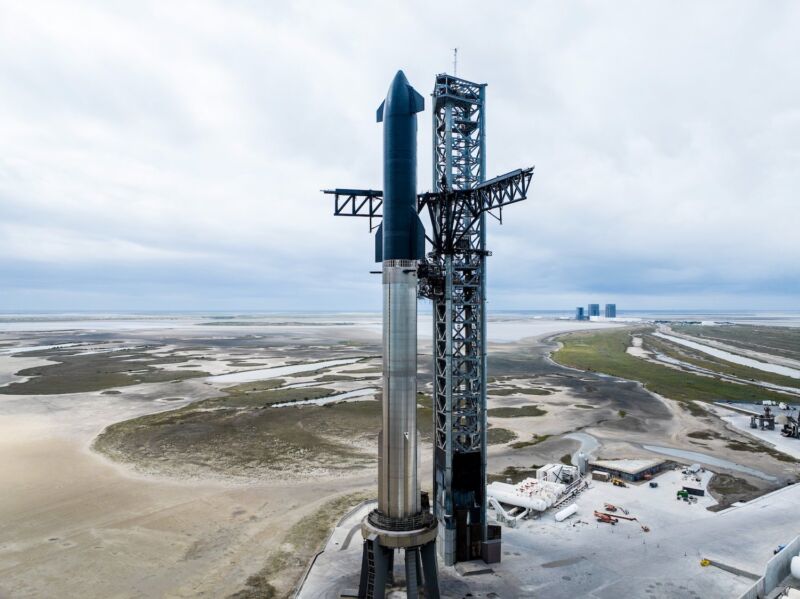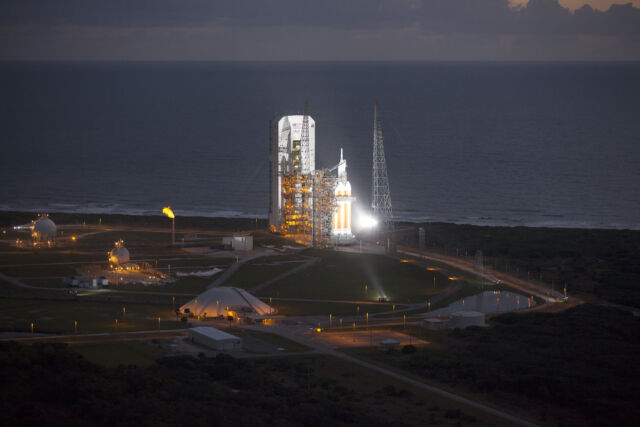
One of the largest launch pads at Cape Canaveral Space Force Station will become vacant later this year after the final flight of United Launch Alliance’s Delta IV Heavy rocket. SpaceX is looking to make the sprawling facility a new home for the Starship launch vehicle.
The environmental review for SpaceX’s proposal to take over Space Launch Complex 37 (SLC-37) at Cape Canaveral is getting underway now, with three in-person public meetings and one virtual meeting scheduled for March to collect comments from local residents, according to a new website describing the plan.
Then federal agencies, led by the Department of the Air Force, will develop an environmental impact statement to evaluate how Starship launch and landing operations will affect the land, air, and water around SLC-37, which sits on Space Force property on the Atlantic coastline.
Environmental studies for rocket launch facilities typically take more than a year, so it will be a while before any major construction begins to convert SLC-37 for Starship launches. In this case, federal officials anticipate publishing a draft environmental impact statement by December, then a final report by October 2025.
More immediately, ULA still has one more Delta IV Heavy rocket to launch from SLC-37 in March with a classified spy satellite for the National Reconnaissance Office. Once that launch is complete, ULA will wind down operations at SLC-37, and eventually turn over the facility back to the Space Force, which will look for a new tenant. For several months, industry sources have pointed to SpaceX as the leading contender to take over SLC-37 after ULA is finished with the launch pad.
But that’s not quite a done deal yet. Last year, a senior official at ULA told Ars on background that the company was also interested in maintaining a presence at SLC-37.
ULA’s new Vulcan rocket, which debuted last month and will replace the Delta IV and Atlas V launch vehicles, uses a different launch pad a few miles up the coast from SLC-37. ULA is upgrading and expanding its ground facilities at Cape Canaveral to ramp up the Vulcan launch cadence, and the ULA official told Ars the company may want to continue using a rocket processing hangar just south of the Delta IV launch pad for storage and horizontal processing of Vulcan rockets.
Details are scarce about everything SpaceX wants to do with SLC-37, but officials wrote on the environmental review website that SpaceX would “modify, reuse, or demolish the existing SLC-37 infrastructure to support Starship-Super Heavy launch and landing operations.”

The history of SLC-37 dates back to the 1960s, when NASA used the site for eight flights of the Saturn I and Saturn IB rockets to prepare for the Apollo program. The facility sat dormant for 30 years until Boeing moved in to ready SLC-37 for the Delta IV rocket, which has now flown 34 times from SLC-37. The launch pad currently includes a 330-foot-tall (100-meter) mobile gantry, a fixed erector, a fixed umbilical tower, and a flame trench for Delta IV missions.
Starship, the world’s largest rocket, would not need any of that that infrastructure, so if SpaceX takes over the pad, the facility will likely undergo extensive demolition and construction.
If SpaceX isn’t cleared to use SLC-37, the company could build a brand new launch pad designated Space Launch Complex 50. If this is the path SpaceX takes, SLC-50 would be built on undeveloped land north of SLC-37 and south of SpaceX’s primary launch pad for the Falcon 9 rocket at Space Launch Complex 40.
Goodbye to LC-49, hello to SLC-37
SpaceX’s interest in setting up shop at SLC-37 shows the company is getting serious about developing a second base for Starship on Florida’s Space Coast. In 2022, SpaceX constructed a launch tower and launch mount for Starship at Launch Complex 39A (LC-39A), located at NASA’s Kennedy Space Center. But the company made little progress there last year as teams focused on Starship test flights from South Texas.
Elon Musk, SpaceX’s founder and CEO, says Starship is the rocket that will make possible his dream of building a settlement on Mars. He has also touted Starship as a vehicle for point-to-point travel on Earth. Both stages of Starship are designed to be fully and rapidly reusable, with the Super Heavy booster and Starship upper stage returning to Earth for propulsive landings. Starship launch pads will double as landing pads.
Before any of those dreams are realized, Starship needs to get into orbit. The first two full-scale Starship test flights last year didn’t make it that far, but SpaceX got close on the second launch in November. SpaceX hopes to achieve a near-orbital mission with the third Starship test launch, perhaps as soon as early March.
Eventually, Musk envisions Starship launching multiple times per day on a variety of missions, carrying people, satellites, cargo, or refueling tankers into orbit. In order to do this, SpaceX will need a lot of launch and landing pads. SpaceX has toyed with the idea of floating offshore launch and landing platforms, but those plans are on hold.
In the near-term, SpaceX plans to build a second Starship launch tower at the company’s Starbase test site in Cameron County, Texas. There’s also the partially-built launch tower at LC-39A, and now SpaceX has set its sights on SLC-37.
SpaceX was previously looking at building another Starship launch pad from scratch on NASA property at the Kennedy Space Center. NASA environmental studies for this location, known as Launch Complex 49, kicked off in 2021. Patti Bielling, a NASA spokesperson, told Ars on Friday the agency is no longer working on Launch Complex 49.
“At this time, there are no activities involving LC-49 on Kennedy,” Bielling said. “Any previous activities regarding LC-49 were suspended, and no actions were taken.”
One of the first operational applications for Starship will be to serve as a human-rated lunar lander for NASA’s Artemis program. SpaceX is developing a version of Starship to ferry astronauts to and from the Moon’s surface, but in order for Starship to reach the Moon, it has to be refueled in low-Earth orbit. This will require perhaps 10 or more refueling flights using a version of Starship called a tanker, all launching in a matter of weeks. Those tanker flights will launch on Super Heavy boosters from pads in Texas and Florida.
In parallel with continued Starship test flights and demonstrating in-space refueling technology, SpaceX needs to build more launch pads to make all this possible. Although SpaceX has backpedaled on several of its Starship launch pad ideas, the company’s interest in SLC-37 suggests it still has big plans for Starship in Florida.

